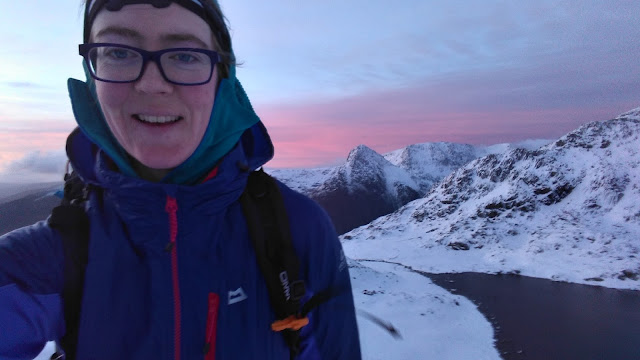With winter just around the corner, and hopefully one full of snow and mountain adventures, I thought I would write an article about how to go ski touring in Snowdonia.
 |
| Ski touring at dawn in Snowdonia |
Weather and Snow Conditions
First things first, you can and people do, get avalanched in Snowdonia so make sure you learn about snow before going skiing. There is no avalanche forecast in Snowdonia either. Below are various ways I build a picture of what the snow conditions may be like:
- Looking at the weather forecast, has it snowed, is snow forecast, does the Met Office mountain weather forecast mention anything under Ground Conditions?
- Read between the lines of the latest UKClimbing welsh winter conditions thread, are there any useful comments or photos of routes recently climbed
- Scour Facebook groups such as Snowdonia winter climbing conditions, north wales skiing etc... for snow updates
- Look at instagram photos taken recently on the peaks you are hoping to ski off
- Look at various webcams, most usefully OVMRO webcams and the Snowdon Webcam.
- Actually get out there and have a look - probably the most reliable method!
 |
| An avalanche in Snowdonia above Nant Peris Photo by Brian Wills |
 |
| Psyched after a great day of skiing in Snowdonia, I took a chance and had a look, and there was more than enough snow to ski and enjoy |
Another really useful too is the BMC Cwm Idwal winter conditions page which provides live temperature readings at various heights and depths of turf.
 |
| The BMC Cwm Idwal winter conditions page |
Iona's snow seeking guidelines
Normally there is more skiable snow than there looks, particularly if there has been a good freeze thaw cycle
The Carneddau tends to hold more snow than the Glyderau and Snowdon ranges
 |
| Looking towards the Northern Carneddau where there is often more snow than elsewhere |
If it's been windy, has the snow been swept onto one side of the hills more than the other? - normally the case in Snowdonia but watch out for the avalanche conditions that come with this.
 |
| The spread of snow across Yr Elen and Carnedd Llewelyn, notice the lack of snow in some areas, particularly ridge lines, or the increase in snow in the gully between the two peaks. |
You don't actually need that much snow to ski on, as when it's frozen the patches of grass between the snow ski quite well too!
When you're out hiking in the summer look for slopes that are grassy underfoot as normally there is only enough snow to cover grass and not rocks and small boulders.
 |
| A variety of terrain in Snowdonia, some of which I had checked out in the summer months before hand |
 |
| The steeper lines here can provide great skiing in addition to climbing |
Often conditions are better in the morning before it gets warmer, so go out and enjoy a dawn patrol
 |
| Setting a skin track before work in March |
Stay safe and have fun
 |
| Keep smiling, it's not every day you get to ski in Snowdonia |








































